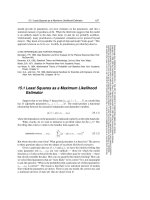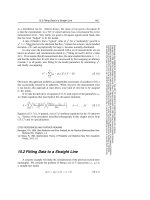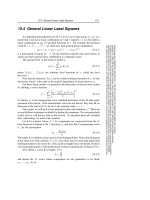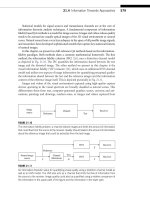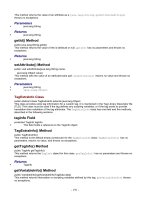THE FRACTAL STRUCTURE OF DATA REFERENCE- P20 doc
Bạn đang xem bản rút gọn của tài liệu. Xem và tải ngay bản đầy đủ của tài liệu tại đây (76.07 KB, 5 trang )
Free Space Collection in a Log
83
Also, in specializing (6.11), we may take advantage of (6.6), in that:
Thus, in the case of the hierarchical reuse model, we obtain:
(6.13)
To define the best free space collection scheme, we must now specify the
values of four variables: f
1
, f
h
, u
1
, and u
h
. These variables must satisfy (6.7),
both as it applies to the pair of variables (f
1
, u
1
) and the pair of variables
(f
h
, u
h
). They must also satisfy (6.13). Finally, they must produce the smallest
possible number of moves per write, as given by (6.10). We are confronted,
therefore, by a minimization problem involving four unknowns, three equations,
and an objective function.
To explore the history dependent strategy, iterative numerical techniques
were used to perform the minimization just described. This was done for a
range of storage utilizations, and for the various values d just listed in a previous
paragraph. The results of the iterative calculations are presented in the three
dashed lines of Figure 6.1.
Figure 6.1 shows that fast destage times yield the smallest number of moves
per write. Nevertheless, it should be noted that prolonged destage times offer an
important advantage. Prolonged destaging provides the maximum opportunity
for a given copy of the data, previously written by the host, to be replaced before
that copy ever needs to be destaged. The ability to reduce write operations
to disk makes moderate
-
to
-
slow destaging the method of choice, despite the
increase in moves per write that comes with slower destaging.
If, for this reason, we restrict our attention to the case of moderate
-
to
-
slow
destaging, the linear model provides a rough, somewhat conservative “ballpark”
for the results presented in Figure 6.1. Putting this in another way, the linear
model appears to represent a level of free space collection performance that
should be achievable by a good history dependent algorithm. At low levels of
storage utilization, however, we should not expect realistic levels of free space
collection to fall to zero as called for by the linear model. Instead, a light,
non
-
zero level of free space collection load should be expected even at low
storage utilizations.
Chapter 7
TRANSIENT AND PERSISTENT DATA ACCESS
The preceding chapters have demonstrated the importance of incorporating
transient behavior into models that describe the use of memory. By contrast,
the models developed so far do
not
incorporate
persistent
behavior. Instead,
for simplicity, we have assumed that interarrivals are independent and identi
-
cally distributed. Since the assumed interarrival times are characterized by a
divergent mean, this implies that, in the long run, the access to every data item
must be transient.
The assumption of independent and identically distributed interarrivals is
not vital, however, to most of the reasoning that has been presented. Of far
more importance is the heavy
-
tailed distribution of interarrival times, which
we have repeatedly verified against empirical data. Thus, the models presented
in earlier chapters are not fundamentally in conflict with the possible presence
of individual data items whose activity is persistent, so long as the aggregate
statistical behavior of all data items, taken together, exhibits heavy
-
tailed char
-
acteristics. So far, we have not confronted the possibility of persistent access
to selected data items, because the models presented in previous chapters did
not require an investigation into statistical differences between one data item
and the next.
In the present chapter, our objective is not so much to develop specific
modeling techniques, but instead to build an empirical understanding of data
reference. This understanding is needed in order to reconcile the modeling
framework which we have pursued so far, with the practical observation that
persistent patterns of access, to at least some data items, do happen, and are
sometimes important to performance. We shall examine directly the persistence
or transience of access to data items, one at a time. Two sources of empirical
data are examined:
86
I/O trace data collected over a period of 24 hours.
Traces of file open and close requests, obtained using the
OS/390 System
Measurement Facility (
SMF), collected over a period of 1 month.
THE FRACTAL STRUCTURE OF DATA REFERENCE
The I/O trace data are used to explore reference patterns at the track image,
cylinder image, and file levels of granularity. The
SMF data allows only files to
be examined, although this can be done over a much longer period.
It should be emphasized that the use of the term persistent in the present
chapter is not intended to imply any form of “steady state”. Over an extended
period of time, such as hours or days, large swings of activity are the rule,
rather than the exception, in operational storage environments. Such swings do
not prevent an item of data from being considered
persistent.
Instead, the term
persistent serves, in effect, to express the flip side of transient. Data that is
persistent may exhibit varying (and unpredictable) levels of activity, but some
level of activity continues to be observed.
Storage performance practitioners rely implicitly on the presence of persis
-
tent patterns of access at the file level of granularity.
Storage performance
tuning, implemented by moving files, makes sense only if such files continue
to be important to performance over an extended period of time. The degree
to which this condition is typically met in realistic computing environments is
therefore a question of some importance.
Many formal studies have undertaken the systematic movement of files,
based upon past measurements, so as to obtain future performance benefits.
Some of the more ambitious of these studies, which have often aimed to reduce
arm motion, are reported in [34, 35, 36, 37]. These studies have consistently
reported success in improving measures such as arm motion and disk response
time. Such success, in turn, implies some level of stability in the underlying
patterns of use.
Nevertheless, the underlying stability implied by such findings has itself
remained largely unexplored. Typically, it has been taken for granted. But the
observed probabilities of extremely long interarrival times to individual items
of data are too high to allow such an assumption to be taken for granted.
In this chapter, we shall find that data items tend to fall, in bimodal fashion,
into two distinguishable categories: either transient or persistent. Those items
which are persistent play a particularly important role at the file level of gran
-
ularity, especially when the number of accesses being made to persistent files
is taken into account.
The strong tendency of persistent files to predominate overall access to
storage provides the needed underpinning for a performance tuning strategy
based upon identifying and managing the busiest files, even if observations
are taken during a limited period of time.
If a file is very busy during such
Transient and Persistent Data Access
87
observations, then it is reasonable to proceed on the basis that the file is likely
to be persistent as well.
As the flip side of the same coin, transient files also play an important role in
practical storage administration. The aspects of storage management involving
file migration and recall are largely a response to the presence of such data.
The present chapter touches briefly on the design of file migration and recall
strategies. The following chapter then returns to the same subject in greater
detail.
1. TRANSIENT ACCESS REVISITED
So far, we have relied on the statistical idea of an unbounded mean interarrival
time to provide meaning to the term transient. It is possible, however, to identify
a transient pattern of references, even when examining a single data item over
a fixed period of time. For example, the process underlying the pattern of
requests presented in Figure 1.1 appears clearly transient, based upon even
a brief glance at the figure. The reason is that no requests occur during a
substuntial part of the traced interval.
To formalize this idea, consider the requests to a specific data item that are
apparent based upon a fixed window of time (more specifically, the interval
(t , t + W], where t is an arbitrary start time and W is the duration of viewing).
Let S be the time spanned by the observed activity; that is, S is the length of
the period between the first and last requests that fall within the interval. The
persistence P of a given data item, in the selected window, is then defined to
be
(7.1)
In the case of Figure 1.1, it would be reasonable to argue that the observed
activity should be characterized as transient, because P is small compared with
unity.
The hierarchical reuse model makes an interesting prediction about the
behavior of the persistence metric P. This can be seen by picking up again
on some of the ideas originally introduced in Subsection 4.2 of Chapter 1.
It should be recalled, in the reasoning of Chapter 1, that the single
-
reference
residency time may assume any desired value. Thus, we now choose to set
τ = W (i.e. we imagine, as a thought experiment, the operation of a cache
in which the single reference residency time is equal to the length of the time
window).
Consider, now, the front end time, as previously defined in Chapter 1. By
the definition of the quantity ∆τ, the rate at which such time passes, in units of
seconds of front end time per second of clock time, is given by rm ∆τ. Also,
by the reasoning previously presented in Subsection 4.2 of Chapter 1, the rate
88
per second at which intervals are touched is given by:
THE FRACTAL STRUCTURE OF DATA REFERENCE
where we assume that the time line is divided into regular intervals of length
= W. Therefore, the average amount of front end time per touched interval
is:
where we have made two applications of (1.11).
But, recalling that front end time begins with the first
I/O and is bounded
by the last
I/O of a cache visit, that a single
-
reference cache visit has a null
front end, and that no two
I/O’s from distinct cache visits can occur in the same
interval, we have the following situation:
Every touched interval contains all or part of exactly one front end.
S can be no longer than the length of that front end or portion of a front end.
Based upon the average amount of front end time per touched interval, we may
therefore conclude that
(7.2)
where strict inequality must apply due to cases in which the front end crosses
an interval boundary.
In many previous parts of the book, we have used the guestimate θ≈
.25. Keeping this guestimate in mind, (7.2) means that we should expect the
examples of the hierarchical reuse model studied up until now to exhibit values
of the persistence metric P that are small compared to unity.
It is important to note that the conclusion just stated applies regardless of
the interval length W. To drive home the significance of this fact, it is useful
to consider a thought experiment. As Figure 1.1 makes clear, patterns of
I/O
requests tend to be “bursty”. Suppose, then, that we wish to estimate the
number of requests in a typical
I/O burst. One possible approach might be to
insert boundaries between bursts whenever a gap between two successive
I/O’s
exceeds some threshold duration. The average number of requests per burst
could then be estimated as the number of requests per boundary that has been
inserted. The results obtained from this approach might obviously be very
sensitive to the actual value of the threshold, however.
An alternative approach, that avoids the need to define a threshold, would
be to examine the activity apparent in time windows of various lengths. For
